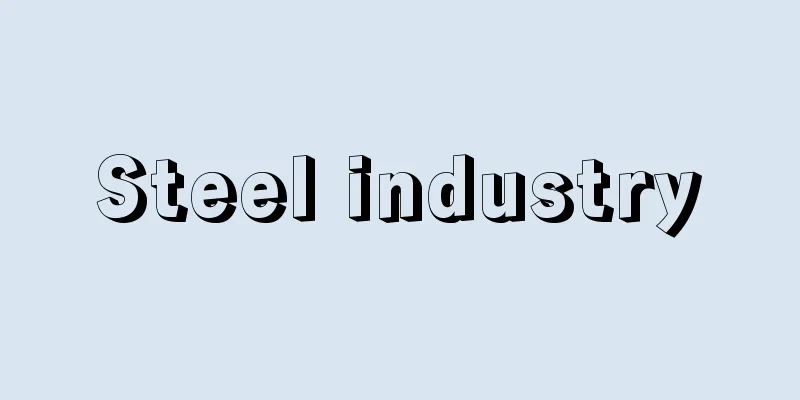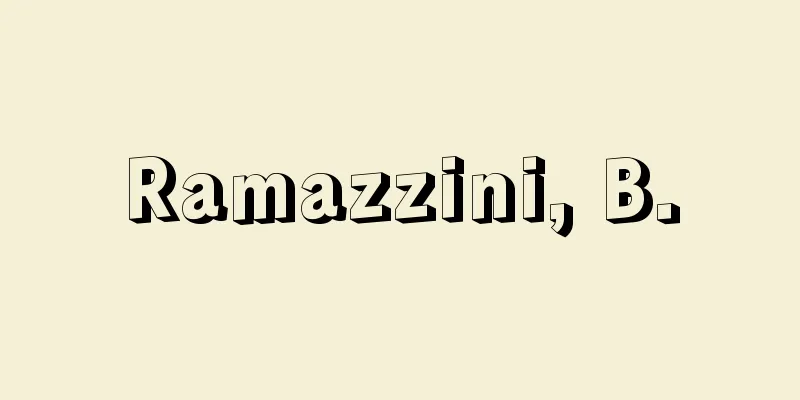Steel industry

|
In the narrow sense, it refers to the production of iron and steel itself, and in the broad sense, it includes the processing of iron and steel, but usually refers to the former, which is the core industry in major industrial countries. Technically, the modern iron and steel industry is said to be a technological system of the "indirect ironmaking method," and its production process consists of three processes: (1) pig iron making, (2) steel making, and (3) rolling. The steel industry is divided into five types of companies in terms of their relationship to these three production processes: (1) blast furnace manufacturers (which have the three processes mentioned above and carry out large-scale integrated production of steel in the order of blast furnace pig iron → converter/electric furnace steel → rolled steel. They are also called integrated pig iron steel companies); (2) flat-plate/electric furnace manufacturers (which have the steelmaking and rolling processes out of the three processes and produce steel using pig iron and scrap iron as raw materials); (3) single-rolling manufacturers (which only have a rolling process and purchase steel and semi-finished products to produce steel); (4) independent blast furnace manufacturers (which only have a pig ironmaking process and produce pig iron in blast furnaces); and (5) drawn steel manufacturers (which mainly purchase scrap iron from steelworks and re-roll it). Some blast furnace and electric furnace manufacturers produce both ordinary steel and special steel, but companies that only produce special steel are sometimes called special steel manufacturers. In the steel industry of major industrial countries, a small number of large blast furnace manufacturers account for the majority of steel production, with the remainder produced by open-type and electric furnace manufacturers and other companies. In other words, the steel industry is a typical oligopoly industry with a high degree of production concentration among large blast furnace manufacturers. In the case of the Japanese steel industry, the four blast furnace companies, Nippon Steel Corporation, JFE Steel, Sumitomo Metal Industries, and Kobe Steel, account for just under 65% of total production, and the major open-type and electric furnace manufacturers, single-press manufacturers, and special steel manufacturers are also affiliated with these four companies, so the concentration of production among the four companies, including their affiliated companies, is extremely high. Currently, Nippon Steel Corporation is one of the world's largest steel manufacturers in terms of production volume, and the other three companies are also large global companies in terms of production volume and asset holdings. [Yoshi Matsuzaki] Global Steel IndustryEarly HistoryAlthough iron production itself has a history as old as humankind, the steel industry as a modern industry was established during the Industrial Revolution in England at the end of the 18th century. During this period, the coke blast furnace technology (operated in 1735), the puddle process (patented in 1784), and the rolling process (patented in 1783) were perfected, and an integrated production technology system of pig iron, wrought iron, and rolling was established. However, at this stage, as seen in the puddle process (corresponding to the current steelmaking stage), only wrought iron (malleable cast iron) could be produced, and mass production technology for steel had not yet been established. In addition, both the wrought iron production process and the rolling process still retained a strong handicraft character. England was the center of steel production during this period. What revolutionized this stage of production technology and paved the way for modern steel technology and industrial organization were the developments of a series of steelmaking technologies from the mid-19th century onwards - Bessemer's converter steelmaking process (patented in 1855, same below), Thomas' basic converter steelmaking process (1878), and Siemens and Martin's open hearth steelmaking process (1864). These new technologies increased the temperature inside the furnace, making it possible to directly refine pig iron and scrap iron into steel in a molten state, thus overcoming the technical limitations of the puddle furnace (where the furnace temperature was low and refinement had to be done in a candy-like state, and the product was wrought iron rather than steel). This is known as the establishment of the modern steelmaking process. The converter and open hearth technologies developed during this period have since been significantly improved, but they remain the basic technologies of the modern steel industry. The new steelmaking processes also had a major impact on the industrial organization of the steel industry. As the converter and open hearth processes made it possible to produce steel, the capacity of these steelmaking furnaces gradually expanded, making mass production possible, and at the same time, the continuity of production between the three processes of blast furnace, open hearth and converter, and rolling mill increased. This created the conditions for the steel industry to mass-supply cheap metal materials and promote heavy industrialization, but it also required huge fixed capital. With the increased amount of invested capital, the steel industry saw the accumulation and concentration of capital, and large companies established their dominance. The steel industry became the stage for the emergence of monopolistic giants, and the industrial foundation of monopoly capitalism. Looking at the changes in steel production from the mid-19th century to World War II, the UK held an overwhelming position until around 1880 (wrought iron era), but after 1890 Germany and the US made significant inroads (steel era). With the development of the steel industries in Germany and the US, huge monopolies such as US Steel (established in 1901) were formed. [Yoshi Matsuzaki] From the end of World War II to the 1970sThe trend of the world steel industry after the Second World War changed significantly around 1970. First, the steel industry in all countries except the United States was hit hard by the Second World War, but recovered between 1950 and 1955, and then developed rapidly in line with the expansion of the world economy. Second, the development of the EC (now the EU), centered on Japan and West Germany, among capitalist countries, and the Soviet Union, among socialist countries, was remarkable, in contrast to the stagnation of the United States and the United Kingdom. In particular, the rapid increase in production in Japan and the Soviet Union completely changed the situation of the steel industry after the war. As a result, third, the world's steel production bases around 1970 were the United States, the Soviet Union, the EC, and Japan, and the production scale of each was about 100 million tons (world production in 1970 was about 600 million tons). Fourth, the change in production was reflected in trade, and the EC countries, including Japan and West Germany, became the world's steel export bases. In 1970, the total steel exports by countries around the world (28 countries) was about 88 million tons, of which Japan accounted for about 17 million tons (20%), West Germany about 12 million tons (14%), the three Benelux countries about 16 million tons (18%), the United States about 6.4 million tons (7%), and the Soviet Union about 7.5 million tons (8.5%). What is noteworthy is that the United States' imports gradually increased, reaching three times its export volume in 1970, turning it into a net importing country. The world economy, especially the capitalist economies, had been expanding steadily until around 1970, but entered a long period of stagnation after the Nixon Statement in August 1971 (a series of dollar defense policies, including the suspension of gold-dollar exchange) and the sudden rise in crude oil prices due to the oil shock in the fall of 1973. The trends in the steel industry during this period can be summarized in the following two points. First, the steel production of major countries entered a total stagnation phase, although to different degrees. Japan and the United States peaked in 1973 (120 million tons and 140 million tons, respectively), West Germany and the six EC countries in 1974 (53 million tons and 130 million tons, respectively), and the Soviet Union was a little later in 1978 (150 million tons), but all of them remained flat or showed an absolute decline. Secondly, in contrast to the stagnation of the developed capitalist countries, there was remarkable development in the NIES (Newly Industrializing Economies) such as South Korea, Taiwan, Spain, and Brazil. Although the scale of production in the steel industries of these countries was still small at this time, their development was supported by industrialization policies and technology transfers from developed countries, and their technological level was quite high, making them rivals of developed countries. The characteristics of steel trade in the 1970s can be summarized as follows: First, the international competitiveness of the Japanese steel industry became stronger than in the previous period, and although production volume peaked in 1973 and then stagnated, export volume continued to grow, reaching about 36 million tons in 1976, and a 30.1% share of the world market. Second, the decline of the American steel industry became evident, and the import ratio (ratio of imports to apparent domestic consumption) has been on the rise since exceeding 10% in 1965, reaching 18.1% in 1978. Around this time, trade friction between Japan, the United States, and Western European countries began to become serious, and calls for import restrictions became stronger in various countries, especially in the United States, Japan's main market. The trigger price system was introduced (1977), and Japan also voluntarily imposed export restrictions. Steel trade became more controlled. Another characteristic of this period was that emerging steel-producing countries began to enter the world market and compete with Japan and the EC countries. This competitive relationship extended to almost all products except for a few high-end products (pipes, high-end thin plates, dimensional lumber for shipbuilding, etc.), and especially for medium- and low-end products, the companies were able to enjoy sufficient price competitiveness by taking advantage of low working conditions. Thus, since the 1970s, the steel industry in developed countries has been marked by stagnation and conflict in both production and trade, while at the same time, competition with newly industrializing countries has intensified. On the one hand, this latter competition has given rise to a trend to restrain technology exports in consideration of the so-called boomerang effect, while on the other hand, it has also brought to light the problem of adjustment of the international industrial structure. [Yoshi Matsuzaki] 1980s-90sThe characteristics of the world steel industry during this period were the stagnation of Japan, Europe, the USSR, and the Soviet Union, and the increasing weight of newly industrializing countries. World steel production reached 700-750 million tons (crude steel), but Japan's production peaked in 1974 and then stagnated at around 100 million tons, the EU at around 150 million tons, and the US at 75-95 million tons, showing a clear tendency to stagnate. In the US, the manufacturing industry declined in the 1980s, while the proportion of electric furnace steel increased (43.8% in 1997) due to the introduction of mini-mills (electric furnace manufacturers), and blast furnace manufacturers were reorganized. In the EU, excess capacity and corporate mergers also became problems. The main reasons for this were the decline in economic growth rates and changes in industrial structure (progress in electronics-related fields and the service economy) in these advanced industrial countries. On the other hand, the Soviet Union (since 1992, the Commonwealth of Independent States (CIS)) saw its economic system fall into disarray with the collapse of the Soviet bloc after the fall of the Berlin Wall and the transition to a market economy, and production volume halved from 160 million tons (1989) to about 80 million tons (1997). On the other hand, the industrialization of developing countries, which began in the NIES in the 1960s, spread to ASEAN (Association of Southeast Asian Nations) countries in the 1970s and to China in the 1980s, and steel production in these countries increased dramatically. For example, in South Korea, steel production increased from about 8.6 million tons (1980) to about 42 million tons (1997), and in China, steel production increased from about 37 million tons (1980) to about 100 million tons (1997). China overtook Japan to become the world's top steel producer. In this way, the weight of less developed industrialized countries increased throughout the 1980s and 1990s, and their competitiveness in the world market also strengthened. However, the general picture for the last 20 years of the 20th century is that this economic growth reached a turning point with the Asian currency crisis in the summer of 1997. [Yoshi Matsuzaki] Since 2000World steel production remained at around 700 million tons throughout the 1980s and 1990s. This trend continued into 2000, remaining flat. However, in 2001, steel production jumped to 850 million tons, surpassed 900 million tons in 2002, exceeded 1 billion tons in 2004, and reached 1.24 billion tons in 2006. This was the result of newly industrialized countries such as South Korea, Taiwan, and India actively building and expanding facilities due to growing domestic demand, with China in particular seeing a remarkable increase in production. China became the world's largest producer in 1996, and in 2006 production had increased to 420 million tons, a fourfold increase from 1996. Since 2000, steel manufacturers have also undergone a restructuring. In 2002, three European companies, Esinor of France, Acelaria of Spain, and Arbet of Luxembourg, merged to form Arcelor, the world's largest steel manufacturer. Mittal Steel, headquartered in the Netherlands, acquired manufacturers from various countries and rapidly expanded its market share, overtaking Arcelor to become the world's largest in 2005. Furthermore, in 2006, the number one steel manufacturer, Mittal Steel, acquired the number two steel manufacturer, Arcelor, to create the giant steel manufacturer ArcelorMittal. This manufacturer's production volume in 2006 reached 117 million tons, which is equivalent to the entire production volume of Japan. [Yoshi Matsuzaki] Japanese Steel IndustryEarly HistoryThe production of iron in Japan has a long history, along with "Wa-tetsu" (Japanese iron) made using the "Tatara" method. However, the modern steel industry began with the operation of the government-run Yawata Steel Works (1901). Yawata Steel Works started as a state-run steelworks, with part of its construction funds coming from reparations for the Sino-Japanese War, technology from Germany, and iron ore from China. As a late-developing capitalist country, it was impossible for the steel industry to develop spontaneously with private capital. After the establishment of Yawata, stimulated by the growing demand for steel, including for military use, private steel companies were established one after another during the Russo-Japanese War and World War I. Most of the major steel companies in Japan today were established during this period. Thus, by 1934 (Showa 9), the volume of steel exports and imports exceeded the volume of imports, and self-sufficiency in steel was achieved. However, even though the speed of development was remarkable, the steel industry in prewar Japan was never able to overcome its lateness. First, despite the establishment and development of private companies, only one of them, Nippon Kokan (NKK), was able to become an integrated pig iron steel company, and all the others were small- to medium-sized open hearth and single pressure manufacturers. Therefore, before the Second World War, the industry was unable to break away from a dual structure in which Yawata Steel Works, an integrated pig iron steel manufacturer, was at the top and there were many small and medium-sized manufacturers, and the level of technology was not high. In 1934, the government-run Yawata Steel Works merged with six private companies to form the large trust Nippon Steel Corporation, but this merger itself was a rescue measure for private companies that had been exhausted during the long recession after World War I, and Nippon Steel Corporation itself was in fact a semi-public and semi-private company. Second, even though the speed of development was fast, the scale of production was significantly smaller than that of developed capitalist countries. Before the Second World War, China's peak production was 4.26 million tons of pig iron (1942) and 7.65 million tons of crude steel (1943), compared with 80.59 million tons in the United States (crude steel, 1943), 20.76 million tons in Germany (same), and 13.24 million tons in the United Kingdom (same). [Yoshi Matsuzaki] From the end of World War II to the 1970sAfter the war, huge capital investments were made to recover from the delays incurred during the prewar and wartime periods and to establish international competitiveness. While relying on technological imports from Europe and the United States, the first rationalization investments (1951-55) and the second rationalization investments (1956-60) were made, which eliminated the gap with Europe and the United States, and further investments from 1961 onwards (construction of a large-scale coastal steelworks with an annual crude steel production of around 10 million tons using the latest production and management technologies) established international competitiveness and made Japan the largest steel exporter. The trends in investment, technological innovation, industrial organization, raw material supply and demand, and trade during this process are as follows. First, capital investment was accompanied by innovations in production and business management technologies, which led to a dramatic increase in labor productivity in the steel industry. The enlargement of blast furnaces in the pig iron production process and the advancement of operating techniques led to a decline in various basic units (raw materials and energy required to produce one ton of pig iron), which led to a decline in pig iron costs. In the steelmaking process, LD converters (pure oxygen top-blown converters) imported from Austria became widespread from around 1957, replacing the conventional open hearth furnaces. This shortened steelmaking time from about 3.5 hours (for open hearth furnaces) to about 30 minutes (for LD converters), and at the same time, energy costs fell sharply. In addition, the introduction of continuous casting technology led to a dramatic reduction in the production process, improvement in yield, and reduction in energy costs. In the rolling process, mass production rolling technology, typified by strip mills (continuous wide-band steel rolling mills), was introduced, which was revolutionary in shortening production time and improving quality. Along with the innovation in production technology, production and management technology also underwent change. The introduction of the American-style line staff system around 1960, and the subsequent development of integrated management of the entire company using computers, were just as significant as the innovation in production technology. In other words, these innovations in production technology and management technology, as well as the pursuit of economies of scale (the larger the production scale, the more costs are saved and the more profits are increased), were the biggest factors that transformed the productivity level of the steel industry after the war and built its international competitiveness. Secondly, this investment process brought about major changes in the industrial organization of the steel industry. One of these was that, against the backdrop of the postwar dissolution of the zaibatsu and the expansion of demand, the three prewar open hearth manufacturers entered the blast furnace sector, and in the 1950s and 1960s, the six major blast furnace manufacturers (Yawata, Fuji, Nippon Kokan, Sumitomo Metals, Kawasaki Steel, and Kobe Steel) engaged in fierce capital investment and price competition (competitive oligopoly), overwhelming small and medium-sized manufacturers. As a result, the six major companies came to account for nearly 70% of production, and the main small and medium-sized manufacturers became affiliated with the major blast furnace manufacturers. The steel industry became a typical oligopoly, but later, with the merger of Yawata and Fuji to form Nippon Steel (1970), the industry took on a more cooperative oligopoly character. Thirdly, the amount of raw material imported by the Japanese steel industry, whose production volume exceeded 100 million tons per year, increased sharply, and at the same time, the source of imports changed significantly. In the case of iron ore, imports were 14.86 million tons in 1960, but exceeded 100 million tons in 1970. Until around 1960, imports were mainly from Southeast Asia and India, but the proportion of South American countries and Australia increased rapidly thereafter, and by 1984, Australia and Brazil accounted for approximately 70% of total imports. The same was true for coking coal, whose import volume rose from 6.17 million tons in 1960 to 46.73 million tons in 1970, and has remained at around 60 million tons since then. In 1960, the United States was the main supplier, but since then, Australia and Canada have rapidly increased. Even in terms of raw material imports, the Japanese steel industry is inseparably linked to the world market. Fourth, the sales market for steel is made up of domestic and overseas markets. Domestically, the main markets are the construction, shipbuilding, automobile, and electrical machinery industries. In the 1950s and 1960s, the domestic market was the main market, but from the late 1960s, the weight of exports began to increase, and direct exports reached about 25% in 1970 and about 36% in 1980 (both in crude steel equivalent), making Japan the world's largest exporter. In 1970, East and Southeast Asia, North America, and other regions each accounted for one-third of exports. Since 1970, the Japanese steel industry has dominated the world market by leveraging its low costs, and exports reached a record high of 37.04 million tons in 1976, partly due to the domestic recession, and exports to the United States also reached 7.6 million tons in 1977, despite the voluntary export restraints that had been in place before 1970. Meanwhile, American steel imports reached 19.41 million tons in 1977 (17.8% of apparent domestic consumption) and 21.33 million tons in 1978 (18.1%), leading to factory closures and worker layoffs at American steel companies. At the same time, the US trade deficit with Japan began to grow, and protectionist sentiment in the US grew, even escalating into a political issue between the Japanese and US governments. As a result, a "trigger price" system was introduced and voluntary restrictions on exports to the US began. After that, both Japan's exports to the US and its total exports remained stable. As mentioned above, the Japanese steel industry achieved unprecedented growth after the Second World War, but as a result, from the second half of the 1970s onwards, the industry was forced to restrict exports due to trade issues with developed countries, and on the other hand, it came to face competition from newly industrializing countries. It can be said that the industry entered a mature stage. [Yoshi Matsuzaki] 1980s-90sDuring this period, the Japanese steel industry continued to maintain the world's largest production volume and high technological level from the 1970s, but it was also a time when the industry faced many challenges as it entered a mature phase. First, domestic demand stagnated against the backdrop of factors such as changes in industrial structure after the two oil crises and increased foreign direct investment by steel-demanding industries, forcing the industry to undertake management diversification and large-scale rationalization (restructuring). This was exacerbated by the impact on steel exports of the strong yen following the Plaza Accord in 1985. [Yoshi Matsuzaki] Business diversification policy and its reviewFirst, against the backdrop of stagnation in the steel industry, the major blast furnace steelmakers all embarked on a policy of diversifying their business operations, such as strengthening their engineering businesses, investing in semiconductor production, spinning off computer-based technologies, and building steelworks overseas and exporting operational technologies. However, new businesses were unsuccessful, except in areas such as computer-based technologies and technology exports, where there was a wealth of technology accumulated through the construction and operation of numerous steelworks after the war, and in the mid-1990s, the diversification strategies were significantly revised, as seen in the withdrawal from semiconductor production. Around the same time, rationalization policies were implemented, which first focused production on highly efficient steelworks and then consolidated steel facilities. In particular, Nippon Steel Corporation, which has a large number of steelworks, saw a series of shutdowns of blast furnaces at its older steelworks. The shutdown of the blast furnace at the Kamaishi Steel Works (Kamaishi City, Iwate Prefecture) was symbolic of this. Furthermore, except for a brief period during the so-called bubble economy (1986-89), the steel industry continued to struggle, and in the early 1990s, cost-cutting measures extended to the rationalization of administrative departments such as headquarters, forcing large numbers of white-collar workers to be seconded, transferred, or quit, resulting in a significant decline in the number of employees at major steel companies. Given that personnel rationalization up until that point had been centered on operational departments, the situation the steel industry finds itself in can be inferred. This struggle was not limited to blast furnace manufacturers, but also affected electric furnace manufacturers. [Yoshi Matsuzaki] The collapse of the bubble economy and the problem of excess capacitySince the collapse of the bubble economy, the Japanese economy has not only been in a prolonged recession, but has also been slow to resolve structural problems such as the disposal of bad loans, which have been made even more serious by the spread of the Thai currency crisis (summer 1997) to other Asian countries and the resulting setback in their economic growth. Japan's economic relations with other Asian countries have grown stronger throughout the 1980s and 1990s, but this has also had a major impact on both trade and investment. The economic crises in Asian countries, coupled with a decline in domestic demand, have brought to the surface the problem of excess capacity in the steel industry, both for blast furnace and electric furnace manufacturers, which was the situation at the end of the 1990s. [Yoshi Matsuzaki] Since 2000Japan's steel industry was stagnant throughout the 1990s, but from the latter half of the decade, signs of recovery began to appear due to the effects of cost reduction and the weakening of the yen. Since 2001, global demand for steel has surged, primarily from China, and as a result, Japan's steel production began to increase from 2002. Crude steel production, which fell to 94 million tons in 1998, hit an all-time high of 121.52 million tons in 2007. In Japan, too, steel manufacturers are undergoing restructuring. In 2002, Kawasaki Steel and Nippon Kokan merged to form the holding company JFE Holdings, and the following year, the two companies reorganized by business division to form JFE Steel, one of the world's leading steel manufacturers. The other three major steel companies (Nippon Steel, Sumitomo Metals, and Kobe Steel) are also moving toward business mergers and capital alliances. [Yoshi Matsuzaki] "Analysis of the Japanese Iron and Steel Industry" by Yoshi Matsuzaki (1982, Nippon Hyoronsha)" ▽ "China's Electronics and Steel Industries - Technological Innovation and Corporate Reform" edited by Yoshi Matsuzaki (1996, Hosei University Press)" ▽ "A Theory of the Modern World Iron and Steel Industry" by Hiromoto Toda (1984, Bunshindo)" ▽ "The Age of Steel" by Morito Nakazawa (Iwanami Shinsho)" ▽ "Iron and Steel Statistics Committee ed., "Handbook of Iron and Steel Statistics," various annual editions (Japan Iron and Steel Federation)" [Reference items] | | | | | | | | | | | | | | | |Source: Shogakukan Encyclopedia Nipponica About Encyclopedia Nipponica Information | Legend |
|
狭義には鉄鋼そのものの生産分野を、広義にはその加工分野をも含むが、通常前者をさし、おもな工業国の基幹産業となっている。近代鉄鋼業は、技術的にいえば「間接製鉄法」の技術体系といわれ、その生産工程は(1)製銑工程、(2)製鋼工程、(3)圧延工程の三つからなっている。 鉄鋼業を構成している企業の形態はこの3生産工程との関係から、(1)高炉メーカー(前述の3工程をもち、高炉銑→転炉・電気炉鋼→圧延鋼材の順序で鉄鋼の大規模一貫生産を行っている。銑鋼一貫企業ともいう)、(2)平・電炉メーカー(3工程のうち、製鋼、圧延工程をもち、銑鉄・屑(くず)鉄を原料として鋼材を生産)、(3)単圧メーカー(圧延工程のみをもち、鋼・半成品を購入して鋼材を生産)、(4)単独高炉メーカー(製銑工程のみをもち、高炉で銑鉄を生産)、(5)伸鉄メーカー(おもに製鉄所から出る屑鉄を購入しその再圧延を行う)の五つに分かれる。高炉メーカーと電炉メーカーのうち、いくつかのメーカーは普通鋼と特殊鋼の両者を生産しているが、特殊鋼のみを生産している企業を特殊鋼専業メーカーとよぶ場合がある。 主要工業国の鉄鋼業では前記の企業のうち、少数の大規模高炉メーカーが鉄鋼生産の大部分を占め、残りを平・電炉メーカーなどの諸企業が生産している。いいかえるならば、鉄鋼業は大規模高炉メーカーの生産集中度の高い典型的な寡占産業である。日本鉄鋼業の場合には、新日本製鉄、JFEスチール、住友金属工業、神戸製鋼所の高炉4社が全生産量の65%弱を占め、また、おもな平・電炉メーカー、単圧メーカー、特殊鋼メーカーもこれら4社の系列下にあり、系列企業をも含めた4社の生産集中度はきわめて高い。現在、新日本製鉄は生産量では世界最大級の鉄鋼メーカーであるが、他の3社も生産量、資産保有量においていずれも世界的大企業である。 [松崎 義] 世界の鉄鋼業前史鉄の生産そのものは人類史とともに古い歴史をもつが、近代産業としての鉄鋼業は18世紀末のイギリスにおける産業革命期に成立した。この時期には、コークス高炉技術(1735操業)、パドル法(1784特許取得)、圧延法(1783特許取得)の諸技術が完成し、銑鉄―錬鉄―圧延の一貫生産技術体系が整った。しかしながら、この段階では、パドル法(現在の製鋼段階にあたる)にみられるように生産できるのは錬鉄(可鍛鋳鉄)であり、鋼の大量生産技術は未確立であった。また、錬鉄生産工程、圧延工程とも手工業的性格を色濃く残していた。この時期の鉄鋼生産の中心国はイギリスであった。 この生産技術段階を革新し現代鉄鋼技術と産業組織に道を開いたのは、19世紀中葉以降の一連の製鋼技術――ベッセマーの転炉製鋼法(1855特許取得、以下同)、トーマスの塩基性転炉製鋼法(1878)、シーメンズとマルタンの平炉製鋼法(1864)――の発展であった。これらの新技術は炉内温度を高め、銑鉄・屑鉄を溶融状態で直接に鋼に精錬することを可能とし、パドル炉の技術的限界(炉内温度が低く飴(あめ)状で精錬せざるをえず、また生産物も鋼でなく錬鉄)を突破した。いわゆる「近代溶鋼法の成立」である。この時期に開発された転炉・平炉技術はその後大幅な改良を加えられつつも現代鉄鋼業の基本的技術となっている。新製鋼法は、また、鉄鋼業の産業組織に大きな影響を与えた。転炉法・平炉法によって鋼の生産が可能となるや、これらの製鋼炉の炉容がしだいに拡大され大量生産が可能となり、同時に、高炉―平・転炉―圧延機という3工程の生産の連続性が高まった。このことは、鉄鋼業が安価な金属材料の大量供給を行い、産業の重工業化を進める条件をつくるとともに、巨額の固定資本を要することともなった。投下資本の巨大化を条件に鉄鋼業では資本の集積・集中が進み、大企業の覇権が確立した。鉄鋼業が独占的巨大企業出現の舞台となり、独占資本主義の産業的土台となったのである。19世紀中葉から第二次世界大戦に至る時期の鉄鋼生産量の推移をみると、1880年ごろまではイギリスが圧倒的地位を占めているが(錬鉄時代)、1890年以降ドイツ、アメリカの進出が著しい(鋼の時代)。このドイツ、アメリカ両鉄鋼業の発展のなかで、USスチール(1901成立)に代表される巨大独占企業が形成された。 [松崎 義] 第二次世界大戦終了から1970年代まで第二次世界大戦後の世界の鉄鋼業の動向は、ほぼ1970年ごろを境に大きく変化した。第一に、第二次世界大戦によってアメリカを除く各国鉄鋼業は大打撃を受けたが、ほぼ1950~55年の間に復興し、その後、世界経済の拡張と歩調をあわせ急速に発展した。第二に、このなかで、資本主義国では日本、西ドイツを中心としたEC(現EU)の、社会主義国ではソ連の発展が著しく、アメリカ、イギリスの停滞と対照的であった。とくに、日本、ソ連の生産量の急増は戦後鉄鋼業の状況を一変せしめた。この結果、第三に、1970年ごろの世界の鉄鋼生産基地はアメリカ、ソ連、EC、日本の四極であり、その生産規模はそれぞれ約1億トン強であった(1970年の世界の生産量は約6億トン)。第四に、生産における状況変化は貿易にも反映し、日本、西ドイツを含むEC諸国が世界の鉄鋼輸出基地となった。1970年の世界各国の鉄鋼輸出量(28か国)は約8800万トンであったが、このうち、日本は約1700万トン(20%)、西ドイツは約1200万トン(約14%)、ベネルックス3国は約1600万トン(約18%)、アメリカは約640万トン(約7%)、ソ連は約750万トン(約8.5%)であった。注目すべきは、アメリカの輸入量が漸増し、1970年には輸出量の3倍に達して純輸入国に転じたことである。 1970年ごろまでほぼ順調に拡大してきた世界経済、とくに資本主義国の経済は、71年8月のニクソン声明(金とドルとの交換停止をはじめとする一連のドル防衛政策)、73年秋のオイル・ショックによる原油価格の急騰とを契機として長期の停滞に入った。この時期の鉄鋼業の動向は次の2点に要約できる。第一に、主要国の鉄鋼生産は程度の差はあれまったくの停滞局面に入った。日本、アメリカのピークは1973年(それぞれ1.2億トン、1.4億トン)、西ドイツ、EC6か国のピークは74年(それぞれ5300万トン、1.3億トン)、ソ連はすこし遅く78年(1.5億トン)であったが、いずれも横ばいないしは絶対的減少を示した。第二に、先進資本主義国の停滞とは対照的に、韓国、台湾、スペイン、ブラジルなどの、NIES(ニーズ=新興工業経済地域)の発展が著しい。これら諸国の鉄鋼業の生産規模自体はこの時期ではまだ小さいが、その発展が工業化政策と先進諸国からの技術移転とに支えられているだけに技術水準はかなり高く、先進国の競争相手になってきた。 1970年代の鉄鋼貿易の特徴は次の2点に要約できる。第一に、日本鉄鋼業の国際競争力は前期以上に強まり、生産量が1973年をピークに停滞局面に入ったにもかかわらず輸出量は伸び続け、76年には約3600万トン、世界市場での輸出シェアは30.1%にも達した。第二に、アメリカ鉄鋼業の衰退が明白になり、輸入比率(国内見かけ消費量に対する輸入品の比率)は1965年に10%を超えて以来増加傾向をたどり、78年には18.1%となった。ほぼこの時期から、日本とアメリカ、西ヨーロッパ諸国との間で貿易摩擦が重大化しはじめ、各国、とくに日本の主要市場であるアメリカで輸入制限を求める声が強くなり、トリガー価格制度が導入(1977)されるとともに、日本も自主的に輸出規制を行うに至った。鉄鋼貿易の管理貿易化が強まったのである。この時期のもう一つの特徴は、新興鉄鋼生産国が世界市場に進出し始め、日本、EC諸国と競合し始めたことである。この競争関係は、一部の高級品種(パイプ、高級薄板、造船用規格材など)を除くとほぼ全品種に及び、とくに中・低級品では、低い労働条件を武器に十分な価格競争力をもつに至った。 このように、1970年以降の先進工業国の鉄鋼業では生産・貿易両面で停滞と対立が際だったが、他方で新興工業国との競争が激化した。この後者の競争は、一方でいわゆるブーメラン効果を考慮した技術輸出抑制の動向を生みつつ、他方では国際的な産業構造の調整問題をも浮かび上がらせた。 [松崎 義] 1980~90年代この時期の世界の鉄鋼業の特徴は、日欧米・ソ連の停滞と新興工業国の比重の増大である。世界の鉄鋼生産量は7~7.5億トン(粗鋼)に達したが、日本は1974年をピークとしてその後1億トン前後、EUは1.5億トン前後、アメリカは7500万~9500万トンで停滞傾向が明瞭となった。アメリカでは80年代に製造業の衰退が進み、他方ではミニミル(電炉メーカー)の進出により電炉鋼の比率が高まり(1997、43.8%)、高炉メーカーの再編成が進んだ。またEUでも設備能力の過剰と企業合併が問題となった。これら先発工業国の経済成長率の低下と産業構造の転換(電子技術関連分野とサービス経済化の進展)がおもな理由である。一方、ソ連(1992以降はCIS=独立国家共同体)は、ベルリンの壁崩壊後のソ連圏の崩壊と市場経済への移行に伴って経済体制そのものが混乱し、生産量は1.6億トン(1989)から約8000万トン(1997)へと半減した。他方、1960年代にNIESに始まった発展途上国の工業化は、1970年代にはASEAN(アセアン=東南アジア諸国連合)諸国に、1980年代には中国にまで波及し、これら諸国の鉄鋼生産量は飛躍的に伸びた。たとえば、韓国では約860万トン(1980)から約4200万トン(1997)に、中国では約3700万トン(1980)から約1億トン(1997)に増加した。中国は日本を抜いて世界でトップの鉄鋼生産国になった。このように1980~90年代を通じて後発工業国の比重が高まり、世界市場でもその競争力は強まってきた。ただ、97年夏のアジア通貨危機を契機にしてその経済成長は転機を迎えていったというのが20世紀末の20年間の概況である。 [松崎 義] 2000年以降世界の鉄鋼生産量は、1980~90年代を通じて、7億トン台で推移していた。この傾向は2000年に入っても変わらず、横ばい状態であった。しかし2001年になると8億5000万トンと鉄鋼生産量が急増し、2002年には9億トン、2004年に10億トンを突破、2006年には12億4000万トンに達している。韓国、台湾、インドなどの新興工業国が国内需要の増大などから、設備の新設、拡張を積極的に行った結果であり、なかでも中国の増産が著しい。1996年に世界最大の生産国となったが、2006年には4億2000万トンと1996年の実に4倍もの増加となっている。 2000年以降は、鉄鋼メーカーの再編も進行した。2002年に、フランスのエジノール、スペインのアセラリア、ルクセンブルクのアーベットのヨーロッパ3社が合併して世界最大の鉄鋼メーカー「アルセロール」となった。また、オランダに本社をもつミッタル・スチールは各国のメーカーを買収し、急速にシェアを拡大、2005年にはアルセロールを抜いて世界最大となった。さらに2006年には1位のミッタル・スチールが2位のアルセロールを買収し、巨大メーカー「アルセロール・ミッタル」が誕生した。このメーカーの2006年の生産量は1億1700万トンに及び、これは日本全体の生産量に匹敵するものであった。 [松崎 義] 日本の鉄鋼業前史日本における鉄の生産自体は「たたら」製鉄法による「和鉄」とともに長い歴史をもつ。しかし、近代鉄鋼業は、官営八幡(やはた)製鉄所の操業(1901)でもって始まった。八幡製鉄所は、建設資金の一部を日清(にっしん)戦争の賠償金に、技術をドイツに、鉄鉱石を中国にそれぞれ求めつつ、国営製鉄所として出発した。後発資本主義国としての日本では民間資本による鉄鋼業の自生的発展は不可能であったからである。この八幡の設立後、軍需を含む鉄鋼需要の増大に刺激され、日露戦争・第一次世界大戦期に民間鉄鋼企業が続々と設立された。現在のわが国の主要鉄鋼企業の大部分はこの時期に設立されている。こうして、1934年(昭和9)には、鋼材の輸・移出量が輸入量を上回り、鉄鋼の自給が達成された。しかしながら、発展速度が著しかったとはいえ、戦前日本の鉄鋼業はその後発性をついに脱却しえなかったといってよい。一つは、民間企業の設立・発展にもかかわらず、そのなかで銑鋼一貫企業になりえたのはようやく日本鋼管(NKK)1社のみで、他はすべて中小規模の平炉・単圧メーカーにとどまったことである。したがって第二次世界大戦以前においては、銑鋼一貫メーカーである八幡製鉄所をトップに多数の中小メーカーが存在するという二重構造を脱却できず、その技術水準は高いものではなかった。1934年、官営八幡製鉄所と民間6社が合併して大トラスト、日本製鉄株式会社が成立したが、この合併自体が、第一次世界大戦後の長期の不況下で疲弊した民間企業の救済策であり、日本製鉄株式会社自体も事実上は半官半民の企業であった。二つには、発展スピードが速かったとはいえ、その生産規模は先進資本主義国に比べ著しく小さかった。第二次世界大戦前の最高生産量は、銑鉄で426万トン(1942)、粗鋼で765万トン(1943)であったが、同時期のアメリカは8059万トン(粗鋼、1943)、ドイツは2076万トン(同)、イギリスは1324万トン(同)であった。 [松崎 義] 第二次世界大戦終了から1970年代まで大戦後、戦前・戦中の立ち後れの回復、国際競争力確立を目的に巨額の設備投資が実施された。欧米諸国からの技術輸入に依存しつつ、第一次合理化投資(1951~55)、第二次合理化投資(1956~60)が進められ、欧米諸国との格差を解消し、さらに1961年以降の投資(最新の生産・管理技術による粗鋼年産1000万トン前後の大型臨海立地型製鉄所の建設)によって国際競争力を確立し、最大の鉄鋼輸出国となった。 この過程における投資と技術革新、産業組織、原料需給、貿易の動向は次のとおりである。第一に、設備投資が生産技術、経営管理技術の革新を伴って進められたため、鉄鋼業の労働生産性は飛躍的に上昇した。銑鉄生産工程における高炉の大型化、操業技術の進歩によって諸原単位(銑鉄1トンを生産するに要する原料、エネルギー)が低下し銑鉄コストが低下した。製鋼工程では1957年ごろから、オーストリアから輸入されたLD転炉(純酸素上吹き転炉)が普及し、従来の平炉にとってかわった。これによって製鋼時間が約3.5時間(平炉の場合)から約30分(LD転炉の場合)に短縮され、同時にエネルギーコストが急減した。また、連続鋳造技術の導入によって、生産工程の短縮、歩留りの改善、エネルギーコストの低下が画期的に進んだ。圧延工程では、ストリップミル(連続広幅帯鋼圧延機)に代表される大量生産型の圧延技術が導入され、生産時間の短縮、品質の改善に画期的意味をもった。生産技術の革新とともに生産・経営管理技術も変革された。1960年前後におけるアメリカ流のライン・スタッフ制の導入、その後のコンピュータを利用した企業全体の一貫管理の進展は、生産技術の革新に劣らぬ意味をもった。つまり、これらの生産技術、経営管理技術の革新と規模の経済性(生産規模が大きいほど費用が節約され収益が増えること)の追求とが戦後鉄鋼業の生産性水準を変革し、国際競争力を築いた最大の要因となった。 第二にこの投資過程は鉄鋼業の産業組織に大きな変化をもたらした。その一つは、戦後の財閥解体と需要の拡大過程を背景として戦前の平炉メーカー3社が高炉分野に参入し、1950、60年代に高炉大手6社(八幡、富士、日本鋼管、住友金属、川崎製鉄、神戸製鋼)が激しい設備投資・価格競争を展開し(競争的寡占)、中小メーカーを圧倒した。その結果、大手6社が生産量の70%近くを占めるようになり、また主要な中小メーカーは大手高炉メーカーの系列下に入った。鉄鋼業は典型的な寡占産業となったが、その後、八幡・富士両社の合併による新日本製鉄の成立(1970)を契機として協調的寡占産業の色彩が強まった。 第三に生産量が年間1億トンを超えるに至った日本鉄鋼業の原料輸入量は急増し、同時に輸入先も大きく変化した。鉄鉱石についてみると、輸入量は1960年では1486万トンであったが70年には1億トンを超えるに至った。輸入先も1960年ごろまでは東南アジア、インドが中心であったが、その後南米諸国、オーストラリアの比重が急速に高まり、84年ではオーストラリア、ブラジルの2国で全輸入量の約70%を占めるに至った。コークス用原料炭の場合も同様で、輸入量は1960年の617万トンから70年には4673万トンに達し、その後は6000万トン前後。輸入先も1960年にはアメリカがおもな供給国であったが、その後オーストラリア、カナダが急増している。原料輸入面からみても日本鉄鋼業は世界市場と不可分の関係にある。 第四に鉄鋼の販売市場は国内市場と海外市場とからなる。国内では建設、造船、自動車、電気機械などの諸産業が主要な市場であり、1950年代、60年代では国内市場がおもな市場であったが、60年代後半から輸出の比重が高まり始め、70年の直接輸出は約25%、80年には約36%(いずれも粗鋼換算)に達し、世界最大の輸出国となった。輸出相手国は、1970年では東・東南アジア、北米、その他地域がそれぞれ3分の1を占めていた。1970年以降日本鉄鋼業は低コストを武器に世界市場を席巻(せっけん)し、輸出量は、76年には国内不況も手伝い史上最高の3704万トンに達し、対米輸出も70年以前に輸出自主規制が始まっていたにもかかわらず77年に同じく760万トンに及んだ。他方、アメリカの鉄鋼輸入量は1977年に1941万トン(国内見かけ消費量の17.8%)、78年に2133万トン(同18.1%)に及び、アメリカ鉄鋼企業の工場閉鎖、労働者の解雇が続出した。同時にアメリカの対日貿易赤字も増大し始め、アメリカに保護貿易の気運が高まり日米政府間の政治問題にまで発展した。その結果「トリガー価格」制度が導入され、対米輸出の自主規制が始まった。以後、日本の対米輸出も全輸出量も横ばいに転じた。 以上述べたように、第二次世界大戦後の日本鉄鋼業は未曽有(みぞう)の発展を遂げたが、その結果、1970年代後半から、一方では先進国との貿易問題に直面して輸出を制限せざるをえず、他方では新興工業国との競争に直面するに至った。産業としての成熟段階に入ったといってよい。 [松崎 義] 1980~90年代この時期の日本鉄鋼業は、1970年代に引き続いて世界最大規模の生産量と高い技術水準とを維持してきたが、他方では成熟期に入った産業として多くの課題に直面した時期でもある。まず、二つのオイル・ショック後の産業構造の変化、鉄鋼需要産業による海外直接投資の増大などの要因を背景に、国内需要が停滞し、経営多角化と大規模な合理化(リストラクチャリング)に取り組まざるをえない状況が生じた。これに拍車をかけたのが85年のプラザ合意以後の円高による鉄鋼輸出への影響であった。 [松崎 義] 経営多角化政策とその見直しまず、本体の鉄鋼分野の停滞を背景に、大手高炉メーカーはそろって、エンジニアリング事業の強化、半導体生産への投資、コンピュータ利用技術の独立事業化、海外での製鉄所建設と操業技術の輸出などの経営多角化政策に取り組んだ。しかし、コンピュータの利用技術や技術輸出など、戦後の多数の製鉄所の建設と操業による技術蓄積が豊かな分野を除いて新規事業は成功せず、90年代なかばには、半導体生産からの撤退にみられるように経営多角化戦略が大幅に見直された。これと前後して進められたのが合理化政策であるが、これは、まず効率の高い製鉄所への生産の集中、それに伴う鉄鋼設備の統廃合の形で進められた。とくに製鉄所の数が多い新日本製鉄では、古い製鉄所における高炉の操業停止が相次いだ。釜石製鉄所(岩手県釜石市)の高炉操業の停止はその象徴であった。さらに、いわゆるバブル景気(1986~89)の一時期を除いて鉄鋼業の苦境は続き、90年代前半にはコスト削減のために本社など管理部門の合理化にまで及び、ホワイトカラーが大量に出向あるいは転籍・退職を余儀なくされ、大手鉄鋼企業の従業員数は大幅に減少した。これまでの人員合理化が現業部門中心に進められてきたことを考えると、鉄鋼業の置かれている状況が推察される。この苦境は高炉メーカーのみにとどまらず、電炉メーカーにも及んだ。 [松崎 義] バブル経済の崩壊と過剰設備問題バブル景気の崩壊後、日本経済は長期の不況のみならず不良債権の処理など構造的な問題の解決に時間を要しているが、これをいっそう深刻にしたのがタイの通貨危機(1997夏)のアジア諸国への波及とその経済成長の頓挫(とんざ)である。1980~90年代を通じて日本とアジア諸国との経済関係はいっそう深まったが、それだけに貿易・投資の両面で大きな影響を受けている。アジア諸国の経済危機は国内需要の減少と相まって、高炉・電炉メーカーを問わず鉄鋼業の過剰設備問題を表面化させているのが1990年代末の状況であった。 [松崎 義] 2000年以降1990年代を通じて停滞していた日本の鉄鋼業であったが、その後半から、コスト削減の効果、円安傾向により回復の兆しが現れてきた。2001年以降、中国を中心に世界的に鉄鋼需要が急増し、そのため2002年から日本の鉄鋼も増産に転じた。1998年に9400万トンにまで減少した粗鋼生産量は、2007年に1億2152万トンと史上最高の生産量を記録している。 なお、日本においても鉄鋼メーカーの再編が進行している。2002年(平成14)には川崎製鉄と日本鋼管が事業統合、持株会社JFEホールディングスを設立し、翌03年に前記2社が事業部門別に再編、世界上位の鉄鋼メーカーJFEスチールが誕生した。また、その他大手鉄鋼3社(新日鉄、住友金属、神戸製鋼)も事業統合や資本提携の動きがある。 [松崎 義] 『松崎義著『日本鉄鋼産業分析』(1982・日本評論社)』▽『松崎義編『中国の電子・鉄鋼産業――技術革新と企業改革――』(1996・法政大学出版局)』▽『戸田弘元著『現代世界鉄鋼業論』(1984・文真堂)』▽『中沢護人著『鋼の時代』(岩波新書)』▽『鉄鋼統計委員会編『鉄鋼統計要覧』各年版(日本鉄鋼連盟)』 [参照項目] | | | | | | | | | | | | | | | |出典 小学館 日本大百科全書(ニッポニカ)日本大百科全書(ニッポニカ)について 情報 | 凡例 |
Recommend
Greater Japan Women's Association - Greater Japan Women's Association
On February 2, 1942 (Showa 17) during the Pacific...
Japan-Mexico Treaty of Amity and Commerce
The Meiji government concluded this treaty with Me...
Setouchi climate - Setouchi climate
One of the climate types in Japan, centered on th...
snobbery
…It is often translated as “snobbish” or “gentlem...
Keihin Industrial Area
It is one of the four major industrial zones that...
Standard weights - standard weights
… A combination weight that can be used to make a...
Gidayu-mono (plays by Gidayu)
Please see the "Den-den Mono" page. Sou...
Pillow - Azuchimakura
〘 noun 〙 A small, long, tied pillow placed on a tr...
《Men's Fight》
... In terms of film history, gangster films are ...
Haguenau
…In France, in particular, the Tréboul type was i...
Fai Fo (English spelling)
The ancient name of Hoi An, the capital of the for...
Delhi, the object of great virtue - Delhi, the object of great virtue
A collection of poems by Maurice Sebe, a French Re...
Uritsuke - Uritsuke
…These customers are often fixed for each peddler...
Provocation (English spelling)
During the ancient Roman Republic, citizens had th...
Tapeworm - Tapeworm
A gigantic, nemertetan worm of the family Baseodis...









